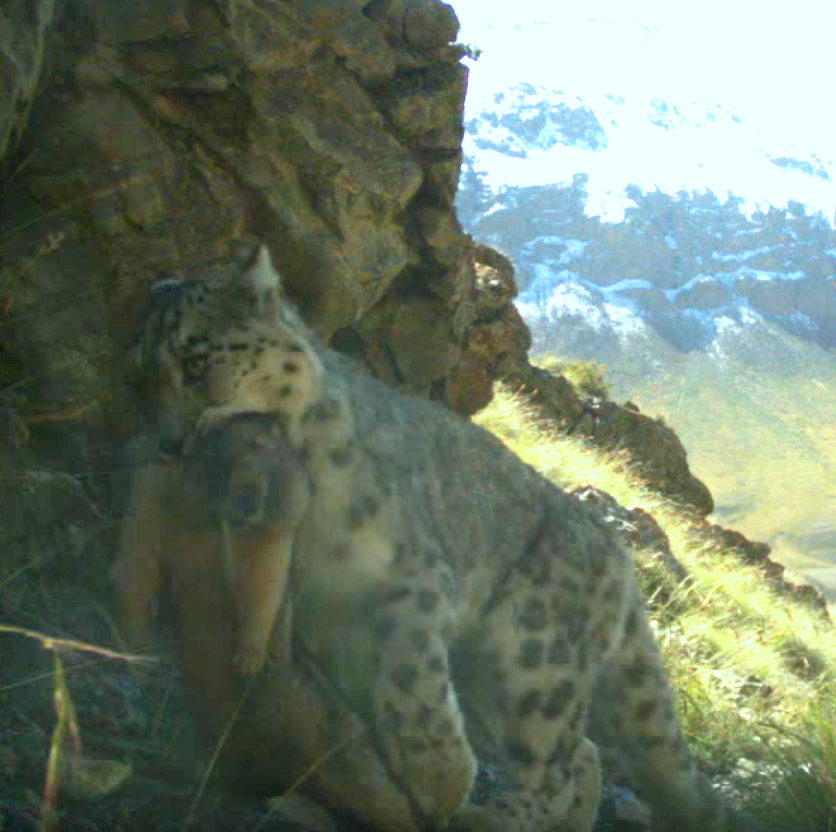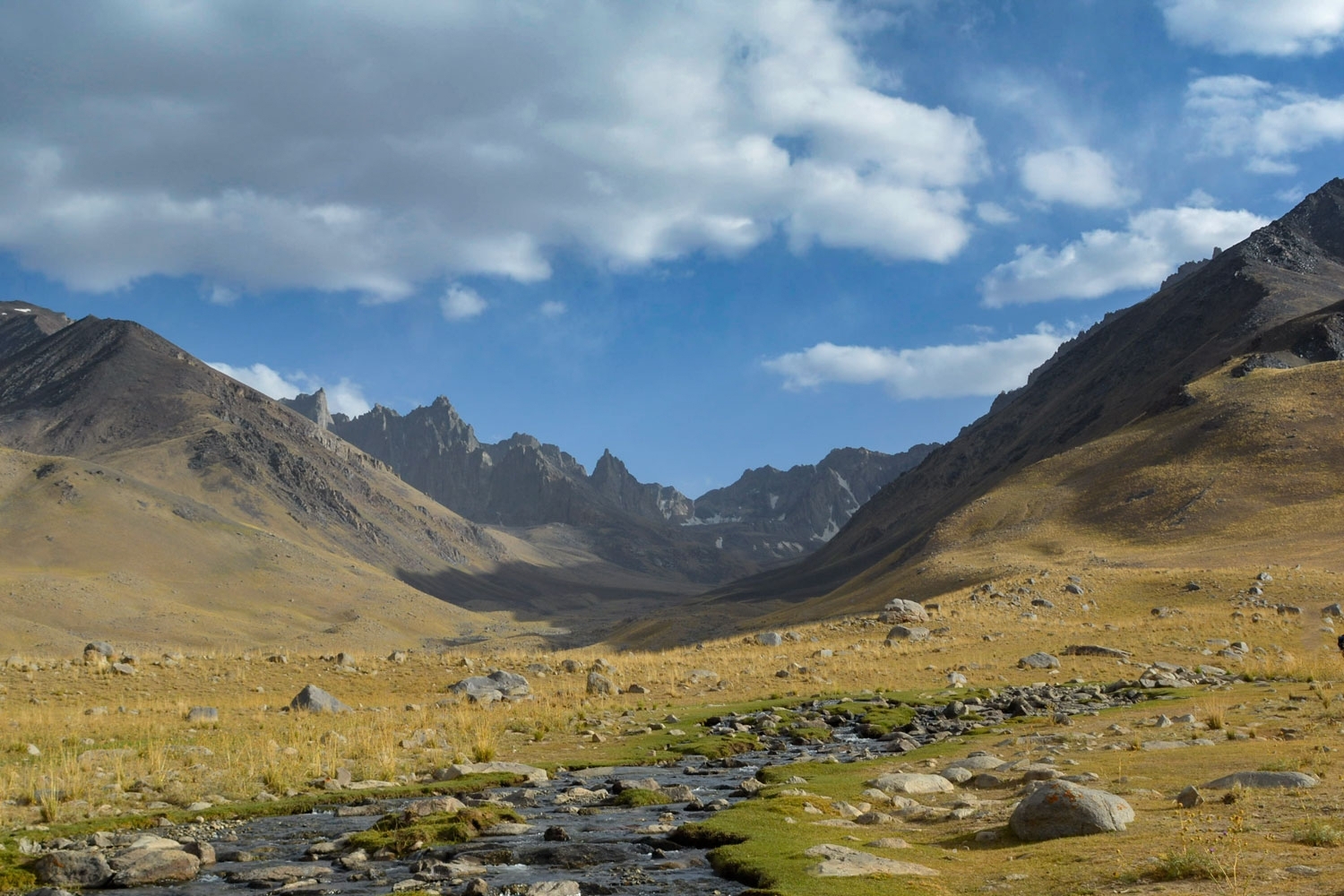|
Sarychat-Ertash State Nature Reserve
The Sarychat-Eertash Nature Reserve ( ky, –°–∞—Ä—ã—á–∞—Ç-–≠—ç—Ä—Ç–∞—à –º–∞–º–ª–µ–∫–µ—Ç—Ç–∏–∫ –∫–æ—Ä—É–≥—É, russian: –°–∞—Ä—ã—á–∞—Ç-–≠—Ä—Ç–∞—à—Å–∫–∏–π –≥–æ—Å—É–¥–∞—Ä—Å—Ç–≤–µ–Ω–Ω—ã–π –∑–∞–ø–æ–≤–µ–¥–Ω–∏–∫) is located in Issyk-Kul Region of Kyrgyzstan. Established in 1995, it currently covers 149,118 hectares. It was established with a purpose of conservation of unique nature complexes, rare and threatened species of flora and fauna of syrt area of Issyk-Kul Region, and maintaining regional environmental balance. The reserve was founded mainly to protect the endangered snow leopard, mountain goat and the argali, a large wild sheep of Central Asia. Other large mammals are Siberian ibex, wild boar, Eurasian lynx, Eurasian wolf and Eurasian brown bear. Smaller and medium-sized mammals, include red fox, pallas cat, stone marten, badger, tolai hare and gray marmot. The reserve is excluded of any usage, including tourism.Jennifer L. McCarthy, Kyle P. McCarthy, Todd K. Fuller, and Thomas M. ... [...More Info...] [...Related Items...] OR: [Wikipedia] [Google] [Baidu] |
Jeti-Ögüz District
Jeti-Ögüz ( ky, Жети-Өгүз , ''seven bulls'') is a Districts of Kyrgyzstan, district of Issyk-Kul Region in north-eastern Kyrgyzstan. Its seat lies at Kyzyl-Suu. Its area is , and its resident population was 93,392 in 2021. It comprises much of the eastern end of the Terskey Ala-too, Terskey Ala-Too Range. Geography The Terskey Alatau, Ak-Shiyrak Range, Borkoldoy Too, Jetim Bel Range, and Kakshaal Too spread across the Jeti-Ögüz District. Major valleys include Issyk-Kul Valley, Upper Naryn Valley, Ak-Shiyrak Valley, and so on. The district contains deposits of ores of tin, tungsten, copper and other metals. Among its large rivers are the Naryn (river), Naryn, Aksu River (China), Saryjaz, Barskoon, Jeti-Ögüz, etc. File:Kyrgyzstan Canyons Dzhety Oguz 001.jpg, Broken Heart Rock File:Base of Juuku Gorge.jpg, Near the end of Juuku Gorge File:Teskey Ala-Too from Ak Terek.jpg, The Teskey Ala-Too range as seen from the beach at Ak Terek (Issyk Kul region), Ak Terek File:Mount ... [...More Info...] [...Related Items...] OR: [Wikipedia] [Google] [Baidu] |
Red Fox
The red fox (''Vulpes vulpes'') is the largest of the true foxes and one of the most widely distributed members of the Order (biology), order Carnivora, being present across the entire Northern Hemisphere including most of North America, Europe and Asia, plus parts of North Africa. It is listed as least concern by the IUCN. Its range has increased alongside human expansion, having been Foxes in Australia, introduced to Australia, where it is considered harmful to native mammals and bird populations. Due to its presence in Australia, it is included on the list of the List of the world's 100 worst invasive species, "world's 100 worst invasive species". The red fox originated from smaller-sized ancestors from Eurasia during the Middle Villafranchian period, and colonised North America shortly after the Wisconsin glaciation. Among the true foxes, the red fox represents a more progressive form in the direction of Carnivore, carnivory. Apart from its large size, the red fox is disting ... [...More Info...] [...Related Items...] OR: [Wikipedia] [Google] [Baidu] |
Protected Areas Established In 1995
Protection is any measure taken to guard a thing against damage caused by outside forces. Protection can be provided to physical objects, including organisms, to systems, and to intangible things like civil and political rights. Although the mechanisms for providing protection vary widely, the basic meaning of the term remains the same. This is illustrated by an explanation found in a manual on electrical wiring: Some kind of protection is a characteristic of all life, as living things have evolved at least some protective mechanisms to counter damaging environmental phenomena, such as ultraviolet light. Biological membranes such as bark on trees and skin on animals offer protection from various threats, with skin playing a key role in protecting organisms against pathogens and excessive water loss. Additional structures like scales and hair offer further protection from the elements and from predators, with some animals having features such as spines or camouflage servin ... [...More Info...] [...Related Items...] OR: [Wikipedia] [Google] [Baidu] |
Nature Reserves In Kyrgyzstan
Nature, in the broadest sense, is the physical world or universe. "Nature" can refer to the phenomena of the physical world, and also to life in general. The study of nature is a large, if not the only, part of science. Although humans are part of nature, human activity is often understood as a separate category from other natural phenomena. The word ''nature'' is borrowed from the Old French ''nature'' and is derived from the Latin word ''natura'', or "essential qualities, innate disposition", and in ancient times, literally meant "birth". In ancient philosophy, ''natura'' is mostly used as the Latin translation of the Greek word ''physis'' (φύσις), which originally related to the intrinsic characteristics of plants, animals, and other features of the world to develop of their own accord. The concept of nature as a whole, the physical universe, is one of several expansions of the original notion; it began with certain core applications of the word φύσις by pre-Socr ... [...More Info...] [...Related Items...] OR: [Wikipedia] [Google] [Baidu] |
Saryjaz
The Aksu River (; ; means "white/clear water" in Uyghur and Kyrgyz languages) is a transboundary river in the Xinjiang province in China and Ak-Suu District of Issyk-Kul Province of Kyrgyzstan. Its upper section in Kyrgyzstan is known as the Saryjaz River or Sarydzhaz River (, ky, –°–∞—Ä—ã–∂–∞–∑). The middle section, between the Kyrgyz-Chinese border and the confluence with the Toshkan, is called Kumarik River (, ky, –°–∞—Ä—ã–∂–∞–∑). The total length of the river is , of which are in Kyrgyzstan. It has a drainage basin of in Kyrgyzstan.{{cite book, script-title=ru:–ò—Å—Å—ã–∫-–ö—É–ª—å. –ù–∞—Ä—ã–Ω. –≠–Ω—Ü–∏–∫–ª–æ–ø–µ–¥–∏—è., trans-title=Issyk-Kul. Naryn.Encyclopedia. , publisher=Chief Editorial Board of Kyrgyz Soviet Encyclopedia, language=ru, location=Frunze, year=1991, isbn=5-89750-009-6 , pages=512 The Aksu is the only one of the Tarim's source rivers to run throughout the year. Course The river takes its roots at the Semyonov glacier in the Central Tian Shan mountains of ... [...More Info...] [...Related Items...] OR: [Wikipedia] [Google] [Baidu] |
Terskey Ala-too
The Terskey Ala-Too ( ky, Тескей Ала-Тоо, Teskey Ala-Too, , russian: Терскей-Алатау, Terskey-Alatau) is a mountain range in the Tian Shan mountains in Kyrgyzstan. It stretches south and southeast of Lake Issyk-Kul, from the river Joon-Aryk near Kochkor in the west to the far northeastern part of Kyrgyzstan. The length of the range is 354 km and its width is 40 km. Its highest peak is Karakol Peak (5,216 m). Another high peak is Boris Yeltsin Peak (5,168 m). Geology Teskey Ala-Too is composed of granites and granodiorites of Caledonian, and granites, metamorphic schists, quartzites, sandstones, and limestones of Paleozoic The Paleozoic (or Palaeozoic) Era is the earliest of three geologic eras of the Phanerozoic Eon. The name ''Paleozoic'' ( ;) was coined by the British geologist Adam Sedgwick in 1838 by combining the Greek words ''palaiós'' (, "old") and ' .... References External links * * Mountain ranges of Kyrgyzstan Moun ... [...More Info...] [...Related Items...] OR: [Wikipedia] [Google] [Baidu] |
Tolai Hare
The tolai hare (''Lepus tolai'') is a species of hare native to Central Asia, Mongolia, and Northern and Central China. It inhabits semi-desert, steppes, rocky habitats, and forest meadows. It is relatively common, even in areas with heavy human disturbance, due to its fast reproductive rate. It is mainly active at dusk and at night but is occasionally active during the day.Aulagnier S.; P. Haffner, A. J. Mitchell-Jones, F. Moutou & J. Zima (2009) ''Mammals of Europe, North Africa and the Middle East'', A&C Black, London. The taxon is formerly included with the cape hare. Description The tolai hare grows to a head-and-body length of between with a tail of . It is rather variable in colouration across its range. The upper parts are some shade of dull yellow, pale brown, or sandy grey with brownish or reddish stripes. The hip region is sometimes ochre or grey. The head has a pale, bare, greyish or ochraceous patch of skin surrounding the eye and extending forwards to near the ... [...More Info...] [...Related Items...] OR: [Wikipedia] [Google] [Baidu] |
Stone Marten
The beech marten (''Martes foina''), also known as the stone marten, house marten or white breasted marten, is a species of marten native to much of Europe and Central Asia, though it has established a feral population in North America. It is listed as Least Concern on the IUCN Red List on account of its wide distribution, its large population, and its presence in a number of protected areas. It is superficially similar to the European pine marten, but differs from it by its smaller size and habitat preferences. While the pine marten is a forest specialist, the beech marten is a more generalist and adaptable species, occurring in a number of open and forest habitats. Evolution Its most likely ancestor is ''Martes vetus'', which also gave rise to the pine marten. The earliest ''M. vetus'' fossils were found in deposits dated to the Würm glaciation in Lebanon and Israel. The beech marten likely originated in the Near East or southwestern Asia, and may have arrived in Europe by the ... [...More Info...] [...Related Items...] OR: [Wikipedia] [Google] [Baidu] |
Pallas Cat
The Pallas's cat (''Otocolobus manul'', also known as the manul, is a small wild Felidae, cat with long and dense light grey fur. Its rounded ears are set low on the sides of the head. Its head-and-body length ranges from with a long bushy tail. It is well camouflaged and adapted to the cold continental climate in its native range, which receives little rainfall and experiences a wide range of temperatures. The Pallas's cat's pupils are rounded, a unique feature among the Felinae. The Pallas's cat was first described in 1776 by Peter Simon Pallas, who observed it in the vicinity of Lake Baikal. In the early 19th century, it was reported to occur in Tibet, and in the Transcaspian Region in the early 20th century. To date, it has been recorded across a large areal extent, albeit in widely spaced sites in the Caucasus, Iranian Plateau, Hindu Kush, parts of the Himalayas, Tibetan Plateau, Altai-Sayan region and South Siberian Mountains. It inhabits rocky montane grasslands and shru ... [...More Info...] [...Related Items...] OR: [Wikipedia] [Google] [Baidu] |
Eurasian Brown Bear
The Eurasian brown bear (''Ursus arctos arctos'') is one of the most common subspecies of the brown bear, and is found in much of Eurasia. It is also called the European brown bear, common brown bear, common bear, and colloquially by many other names. The genetic diversity of present-day brown bears (''Ursus arctos'') has been extensively studied over the years and appears to be geographically structured into five main clades based upon analysis of the mtDNA. Description The Eurasian brown bear has brown fur, which ranges from yellowish-brown to dark brown, red-brown, and almost black in some cases; albinism has also been recorded. The fur is dense to varying degrees and the hair can grow up to in length. The head normally is quite round in shape and has relatively small rounded ears, a wide skull and a mouth equipped with 42 teeth, including predatory teeth. It has a powerful bone structure and large paws equipped with claws that can grow up to in length. The weight varie ... [...More Info...] [...Related Items...] OR: [Wikipedia] [Google] [Baidu] |

.jpg)

.jpg)


.jpg)

_female_3.jpg)